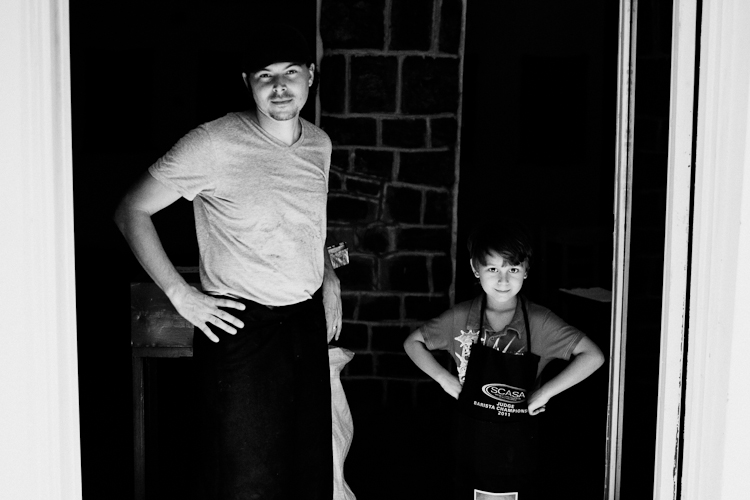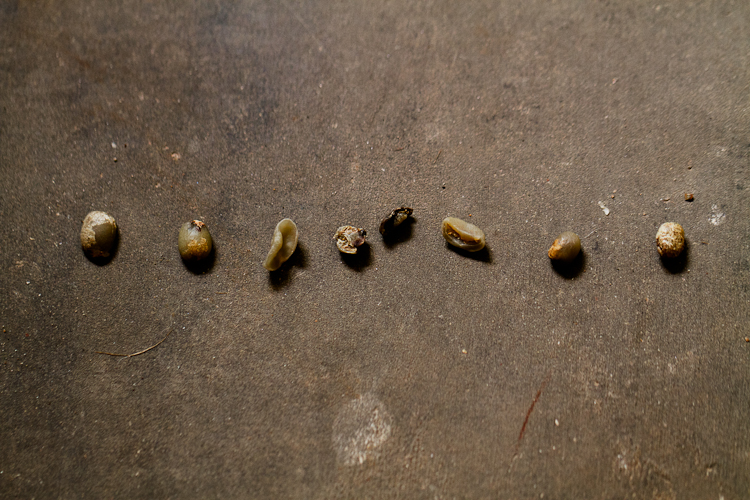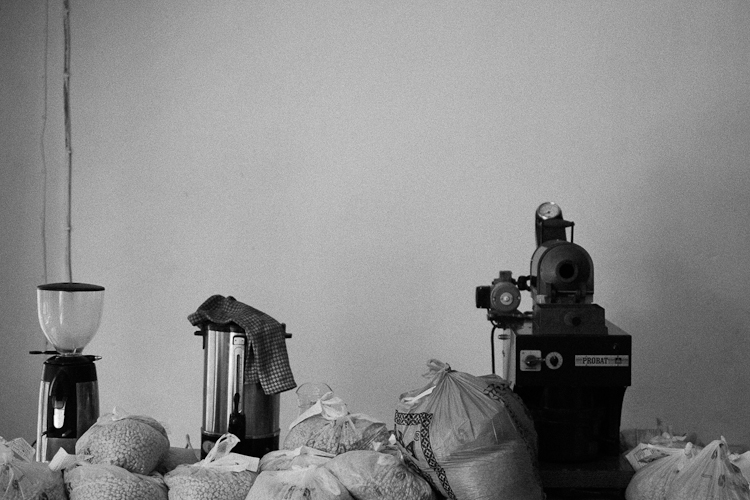
{real men wear aprons. in the lab-o.}
How do you “cup coffee” and how do you get a job doing it?
This is a question I get asked a lot. To say that I’ll answer one part now and one part later will draw the questioning eyebrow of Camera Girl who knows that I drop empty promises about follow up posts. I think we are going to have to risk the eyebrow here and briefly tell you how I became a “professional coffee cupper” with the (not so empty) promise of a follow up post detailing the “how to.”

{Hulling coffee: The first step in dry milling is the removal of what is left of the fruit from the bean, whether it is the crumbly parchment skin of wet-processed coffee, the parchment skin and dried mucilage of semi-dry-processed coffee, or the entire dry, leathery fruit covering of the dry-processed coffee. Thanks Wiki. This is done on a small scale at our lab so that the samples we cup match what the end consumer gets.}
{Hulled beans and the parchment that was removed during hulling.}
Desperation for a good cup of coffee in South Africa in the early 2000’s was the starting place of it all for me.
The reality is that if we moved back to South Africa today we would have so many great choices for our morning cuppa. For just a taste of what’s available now in SA you can look up Bean There, Origin, Truth, Deluxe, Rosetta, TriBeCa, Espresso Lab, Haas, Bean Green, Colombo, Beaver Creek, Redberry…. and the list just keeps going and growing. In fact I see a whole new blog post on doing a South African coffee crawl, but let’s not make any promises. When we moved from Minneapolis, MN to Durban, South Africa in 2002 very few of the above options existed. It became a game for us to try and find great coffee. This led to a personal awakening… both coffee and people really mattered to me. From there, it was a hop skip and a jump to becoming a Barista trainer and then a Q Grader and then moving to a coffee producing country.

{Blowing excess parchment off the beans and little hands help pick out defects before roasting.}
{Defects I… or our child labor… that’s a joke… sort of… look for and hand-pick out before roasting.}
Coffee cupping is a lot like wine tasting.
In fact, the coffee industry really tries hard to be even more snobby than the wine people out there just to show the world how serious we are about coffee. There are coffee cupping flavor wheels, proper scientific procedures and strict controls attached to cupping protocol, various coffee boards and professional organizations, and perhaps the weirdest of all (to non-coffee geeks) is a coffee cupping competition involving hard fought battles on which cupping form is best. But this post is not to digress into the belly of coffee cupping politics, it is to give you a little taste of what I do on a near daily basis.
{The coffee samples begin to pour into the lab. Literally.}
Now I’m not exactly a scientist, I’m actually a fine art major turned coffee specialist.
Cupping is what I do to discover if a coffee is truly special, what price the farmers should likely get, and who (in the Western world) I think is most likely to appreciate it the most. After the coffee cupping comes the real work… chasing samples, following lots, making sure contracts are fulfilled, and most importantly in Burundi… getting the coffee onto the truck and out of the country.
Next time I do a blog “drop in” I’ll provide a detailed look at how to cup coffee. I pinky swear.
Coffee Guy





Grandma Sue & Grandbaba are anticipating the follow up article.
Love to hear what you and your wife and kidds are doing! :)
Start to follow you!!!